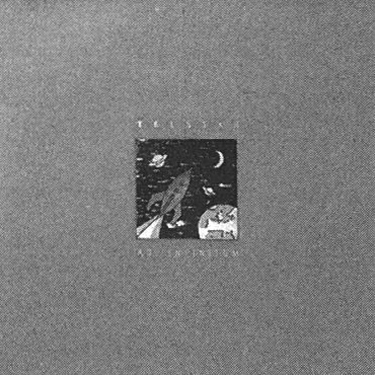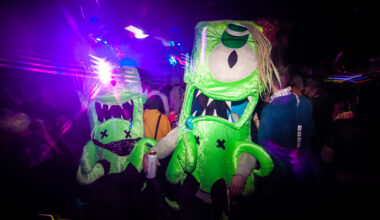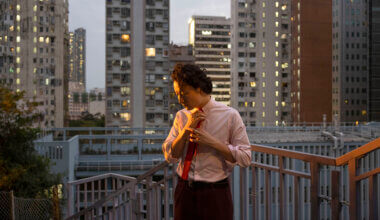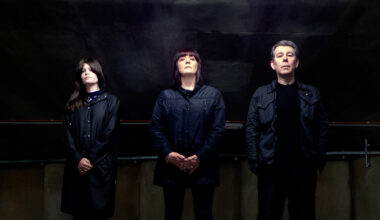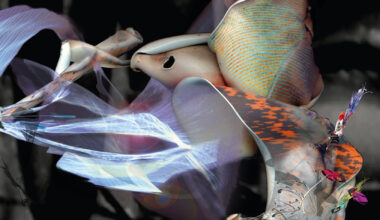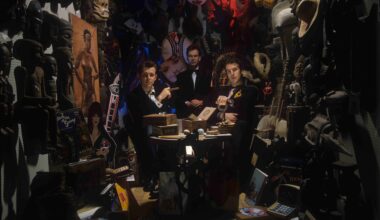Collecting a dazzling array of New Order production jobs stretching back to the 80s, the scope and scale of Manchester’s finest when behind a mixing desk is laid bare on the ‘New Order Presents Be Music’ compilation
You know how it is when your favourite band can’t make records fast enough to quench your thirst? Worse is the thought that one day they’ll split leaving no more green bottles sitting on a wall. If you’re lucky, they’ll scatter in different directions and continue to make music, none of which helps because it’s that sum of the parts you hanker for.
There are of course exceptions. Take New Order. We know about Bernard’s excursions with Electronic and Bad Lieutenant, we know Hooky’s offshoots Revenge, Monaco, Freebass and The Light and there’s Stephen and Gillian’s shiny pop sideline The Other Two. Most of which are a delight. What you may not know is there’s more. Much more.
Over the years, New Order have had often secret lives as producers. And the fruits of their prolific mixing desk labours are served up here on ‘New Order Presents Be Music’, a rather fine three-CD set compiled by James Nice, big chief at the legendary Les Disques du Crépescule label and sister imprint Factory Benelux.
So what is Be Music? The name first cropped up in February 1982 as a Peter Hook producer credit on a Stockholm Monsters’ b-side, ‘Death Is Slowly Coming’. The tag was then adopted by all four band members as a generic credit for production work on a string of classic Factory Records releases… or more accurately Factory Benelux outings, the label benefitting from releasing much of this fine work as the mothership slowly ate itself.
While a raft of artists – including Section 25, Quando Quango and 52nd Street – all felt New Order’s production love, the Be Music heyday was short-lived, ending around the release of their own ‘Low Life’ album in May 1985 when the band reverted to their own names for remix and production work, which included Technotronic, Nine Inch Nails and The Stone Roses.
“Producing was a really important sideline,” acknowledges Sumner in the sleevenotes. “All the groups were skint, but I wasn’t doing it for charity, I wanted to learn the craft. Production is about gaining experience and making mistakes… so I thought I’d make my mistakes on these people’s records!”
We caught up with James Nice to find out more about this rather special collection.
The anonymity of New Order all working under the same pseudonym is a very Factory notion isn’t it?
“Maybe more of a Rob Gretton notion. In his book ‘Substance’ Peter Hook suggests that the collective identity came about because Rob wanted to stop any one member of the band making a name for themselves outside New Order, and for all four of them – or five, if you include Rob himself – to be seen as a single entity. I think Rob may have copped some moves from Pink Floyd too: relative anonymity, no press interviews, highbrow cover art by a single design director… ‘Closer’ and ‘Blue Monday’ were even recorded at the Floyd’s own studio, Britannia Row.”
In some respects the idea of Be Music still continues today doesn’t it?
“If you go and see Hooky live it’s very up close and personal, whereas a New Order gig is more about the light show and the visual projections. They deliberately avoid foregrounding the musicians onstage. Anonymity can have a downside though. One of the very best Be Music productions is ‘Can’t Afford (To Let You Go)’ by 52nd Street. For years I thought Bernard Sumner produced that, when in fact it was Stephen Morris.”

Where did their keen interest in production work come from?
“In the early 80s, New Order invested a lot of money in state of the art electronic kit, and producing other artists was a good way of testing it out. They also took on production to help out groups that they liked, or were mates, and couldn’t afford their own Emulator I. You could say it was a healthy mixture of self-interest and benevolence.”
Much of the output appeared on Factory Benelux rather than Factory. How come?
“I think there were two main reasons. One is that Factory had just invested a huge amount of money in The Haçienda, so cashflow was often an issue, whereas Factory Benelux in Belgium was simply a record label and could turn a single around in a few weeks. The other reason is Rob Gretton and Tony Wilson didn’t agree about dance music. Rob loved it, whereas Tony considered pure dance music insufficiently intellectual, so finances aside I suspect Tony was quite happy for releases to slip out via Benelux instead. He changed his mind a few years later, of course, once house music reversed The Haçienda’s fortunes.”
The golden age of Be Music was between ‘Blue Monday’ and ‘Low Life’, which is quite a narrow window. Why such a brief period?
“Well, 1982 to 1985 was certainly the most prolific period. Having said that, Bernard Sumner only ever produced one entire album for another band, Section 25’s ‘From The Hip’. He found producing like that swallowed too much time and it began to get in the way of New Order completing their own material. I know that Stephen and Gillian found the Thick Pigeon album hard work too.”
Their production work wasn’t all floorfillers though, was it?
“Peter Hook tended to work more with guitar bands like Stockholm Monsters, although ‘Fate/Hate’ by Nyam Nyam is pure electro-disco. Stephen Morris likes a bit of pure pop, which you can hear on his albums with Gillian as The Other Two, as well as Life, who issued a couple of singles on Factory. But he also likes more abstract and leftfield stuff too, be it Thick Pigeon or Factory Floor.”
The set throws up a few pop quiz nuggets… like Johnny Marr played on ‘Triangle’ by Quando Quango!
“It passed largely unnoticed because he wasn’t credited on the record. At the end of 1981 Tony Wilson did try to interest Johnny Marr in joining Section 25, who’d just sacked their guitarist because he refused to fly to gigs abroad. I doubt that combination would have lasted very long. Can you imagine Larry Cassidy waving gladioli around on ‘Top Of The Pops’?”
And we also discover that Donald “Dojo” Johnson of A Certain Ratio was an unsung in-house Factory producer.
“Don’s a consummate musician and a world class drummer. I saw him backing the Kane Gang once and couldn’t help thinking, why aren’t you guesting with Steely Dan? In terms of his production collaborations with Bernard as Dojo and Be Music, maybe you could say that Donald brought the groove and Bernard the gadgetry.”
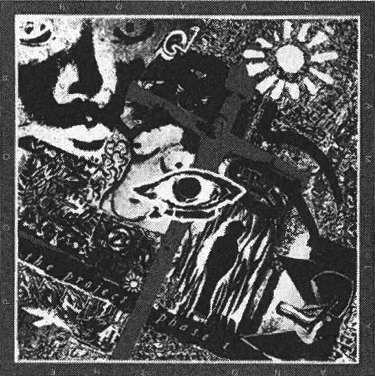
There were three original tracks released as Be Music weren’t there?
“‘Ode To Joy’ and ‘Rocking Carol’ were a pair of knockabout electro ditties issued on a Haçienda flexidisc, FAC 51B, given away on Christmas Eve 1982. We’ve since reissued both tracks on an expanded version of the Crépuscule festive album ‘Ghosts Of Christmas Past’. In fact, all four members of New Order appeared in hard-to-recognise cartoon form on the cover of the 1986 edition, but not on the record itself. The third track was an instrumental by Peter Hook, which appears in the boxset as ‘Lavolta Lakota Theme’. It was used as live intro music for a band he mentored, Lavolta Lakota, and originally appeared on a Crépuscule compilation as ‘Theme (Homage à MGM)’, credited to Be Music. This time around Peter wanted it billed differently.”
How did the idea of a compilation come about?
“The idea came to me while driving home from seeing New Order perform at Latitude Festival last July. I was blown away by how good their show was and how current the group still sound, especially on the new material from ‘Music Complete’. I can’t think of another band who are still that creative in the fourth decade of their career. I also wanted to phase out two older Be Music collections we released a decade ago, not least because quite a few missing mastertapes had since turned up.”
How long has it been in the making?
“Not that long. We own or administer quite a lot of this catalogue ourselves, and New Order were behind it from the get-go, they’ve always been really supportive when the right project comes along. so that made it relatively easy to clear the artists we hadn’t worked with before, like Factory Floor, Tim Burgess and Fujiya & Miyagi. Factory Floor were a key component because Stephen has worked with them more than once, and their tracks are kind of the ultimate endpoint in terms of his work on Disc 2. We’d already commissioned a couple of remixes from Stephen ourselves, for Section 25 and Helen Marnie of Ladytron. The Section 25 recordings span 30 years in fact: from 1979, when Rob Gretton and Ian Curtis produced their first single, through their 1980s recordings with Bernard, and finally the 2010 reboot of ‘Hilltop’ by Stephen.”
Did you face any particular challenges putting the set together?
“The artwork! It wasn’t an easy project as it’s a multi-artist compilation, yet still needs to reflect something of the design heritage of New Order, and to a lesser extent Factory. Matt Robertson designed it – he wrote the Factory ‘Complete Graphic Album’ book for Thames & Hudson in 2007, and also works with Peter Saville, who oversaw this project. The original plan was to adapt the B Music logo seen on the labels of the ‘Movement’ album and ‘Procession’ single in 1981, but Peter noticed the stylised ‘B’ is in fact an Eszett, which by unhappy coincidence is the German consonant/ligature for SS. So that had to go. We then settled on a very high resolution scan of a textured paper, which is a vague nod to the boxed cassette editions produced by Factory from 1984 onwards. It’s not actual textured paper on the CD box or vinyl cover, more a kind of trompe-l’œil effect. I think my liner notes run to something like 10,000 words, but unfortunately you only get those in the CD booklet.”
Any tracks that got away?
“It would have been great to include Bernard’s ‘Haçienda’ remix of ‘Rockin’ Over the Beat’ by Technotronic from 1990. It’s one of the last remixes he did, and a cracker to boot. Stephen and Gillian also remixed a couple of Nine Inch Nails tracks for their ‘Year Zero Remixed’ project in 2007, which are more filmic than dancey. But they’re controlled by major labels and therefore hard to licence, added to which you’re then limited as to where you can sell the whole album, and for how long. Hooky produced the third Stone Roses single, ‘Elephant Stone’, but truthfully I didn’t even shortlist it, partly for similar licensing reasons, and also because it’s not really a classic.
“Tony Henry of 52nd Street is also sitting on a couple of great unreleased tracks. One is an unreleased final single for Factory, ‘Look I’ve Heard It All Before’, a fantastic pop-soul song produced by Stephen. The other is some kind of madcap electro collaboration with Bernard under the name of Sunshine Valley Dance Band, which I’ve still not heard.”
‘New Order Presents Be Music’ is out on Factory Benelux
